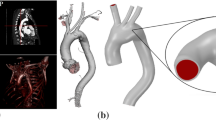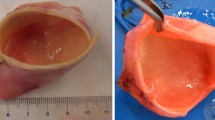Abstract
This work presents the modelling and simulation of the mechanical behaviour of the human aortic arch under in vivo conditions with pressure levels within the normal and hypertension physiological range. The cases studied correspond to young and aged arteries without cardiovascular pathologies. First, the tissue of these two groups is characterised via in vitro tensile test measurements that make it possible to derive the material parameters of a hyperelastic isotropic constitutive model. Then, these material parameters are used in the simulation of young and aged aortic arches subjected to in vivo normal and hypertension conditions. Overall, the numerical results were found not only to provide a realistic description of the mechanical behaviour of the vessel but also to be useful data that allow the adequate definition of stress/stretch-based criteria to predict its failure.










Similar content being viewed by others
References
Al-Okaili R, Schwartz ED (2007) Bilateral aortic origins of the vertebral arteries with right vertebral artery arising distal to left subclavian artery: case report. Surg Neurol 67:174–176
Beller CJ, Labrosse MR, Thubrikar MJ, Robicsek F (2004) Role of aortic root motion in the pathogenesis of aortic dissection. Circulation 109:763–769
Beller CJ, Labrosse MR, Thubrikar MJ, Szabo G, Robicsek F, Hagl S (2005) Increased aortic wall stress in aortic insufficiency: clinical data and computer model. Eur J Cardiothorac Surg 27:270–275
Braverman A, Thomson R, Sanchez L (2010) Braunwald’s heart disease (Chapter 60: Diseases of the aorta), 9th edn. Elsevier, Philadelphia
Celentano D (2001) A large strain thermoviscoplastic formulation for the solidification of S.G. cast iron in a green sand mould. Int J Plast 17:1623–1658
Chiesa R, Moura M, Lucci C, Castellano R, Civilini E, Melissano G, Tshomba Y (2003) Blunt trauma to the thoracic aorta: mechanisms involved, diagnosis and management. J Vasc Bras 2(3):197–209
Chuong CJ, Fung YC (1986) On residual stresses in arteries. ASME J Biomech Eng 108:189–192
De Caro E, Trocchio G, Smeraldi A, Calevo MG, Pongiglione G (2007) Aortic arch geometry and exercise-induced hypertension in aortic coarctation. Am J Cardiol 99:1284–1287
Delfino A, Stergiopulos N, Moore J, Meister J (1997) Residual strain effects on the stress field in a thick wall finite element model of the human carotid bifurcation. J Biomech 30:777–786
Demiray H (1972) On the elasticity of soft biological tissues. J Biomech 5:309–311
Di Martino ES, Vorp DA (2003) Effect of variation in intraluminal thrombus constitutive properties on abdominal aortic aneurysm wall stress. Ann Biomed Eng 31:804–809
Doyle BJ, Cloonan AJ, Walsh MT, Vorp DA, McGloughlin TM (2010) Identification of rupture locations in patient-specific abdominal aortic aneurysms using experimental and computational techniques. J Biomech 43:1408–1406
Doyle BJ, Killion J, Callanan A (2012) Use of the photoelastic method and finite element analysis in the assessment of wall strain in abdominal aortic aneurysm models. J Biomech 45:1759–1768
Erbel R, Eggebrecht H (2006) Aortic dimensions and the risk of dissection. Heart 92:137–142
Ergin MA, Spielvogel D, Apaydin A, Lansman SL, McCullough JN, Galla JD, Griepp RD (1999) Surgical treatment of the dilated ascending aorta: when and how? Ann Thorac Surg 67:1834–1839
Field M, Richens D (2006) Anticipatory valsalva-type response as a contributory factor in low impact blunt traumatic aortic rupture. Med Hypotheses 67:87–92
Field M, Sastry P, Zhao A, Richens D (2007) Small vessel avulsion and acute aortic syndrome: a putative aetiology for initiation and propagation of blunt traumatic aortic injury at the isthmus. Med Hypotheses 68:1392–1398
Fung Y (1993) Biomechanics. Mechanical properties of living tissues. Springer, New York
Gao F, Watanabe M, Matusuzawa T (2006) Stress analysis in a layered aortic arch model under pulsatile blood flow. Biomed Eng Online 5:25
García-Herrera CM, Celentano DJ, Cruchaga MA, Rojo FJ, Atienza JM, Guinea GV, Goicolea JM (2012a) Mechanical characterisation of the human thoracic descending aorta: experiments and modelling. Comput Methods Biomech Biomed Eng 15:185–193
García-Herrera CM, Celentano DJ, Cruchaga MA (2012b) Bending and pressurisation test of the human aoritc arch: experiments, modelling and simulation of a patient-specific case. Comput Methods Biomech Biomed Eng (in press)
Goicolea J, Atienza JM, Burgos R, García-Touchard A, Goicolea J, Guinea G, Mingo S, Montero C, Salas C (2006) Biomecánica aórtica y su correlación in vivo, estudio del comportamiento mecánico y de la rotura de aorta y su correlación ecocardiográfica, histológica y molecular. Protocolo de extracción de muestras. Hospital Universitario Puerta de Hierro, Madrid
Govindjee S, Mihalic PA (1996) Computational methods for inverse finite elastostatics. Comput Methods Appl Mech Eng 136:47–57
Holzapfel GA (2000) Non linear solid mechanics. Wiley, West Sussex
Hariton I, deBotton G, Gasser TC, Holzapfel GA (2007) Stress-modulated collagen fiber remodeling in a human carotid bifurcation. J Theor Biol 248:460–470
Holzapfel GA, Sommer G, Auer M, Regitnig P, Ogden RW (2007) Layer-specific 3D residual deformations of human aortas with non-atherosclerotic intimal thickening. Ann Biomed Eng 35:530–545
Koullias G, Modak R, Tranquilli M (2005) Mechanical deterioration underlies malignant behavior of aneurysmal human ascending aorta. J Thorac Cardiovasc Surg 130:677.e1–677.e9
Laurent S, Cockcroft J, Bortel LV, Boutouyrie P, Giannattasio C, Hayoz D, Pannier B, Vlachopoulos C, Wilkinson I, Struijker-Boudier H (2006) Expert consensus document on arterial stiffness: methodological issued and clinical applications. Eur Heart J 27:2588–2605
Li Z, Kleinstreuer C (2005) A new wall stress equation for aneurysm-rupture prediction. Ann Biomed Eng 33:209–213
Liu CY, Chen D, Teixido-Tura G, Chugh AR, Redheuil A, Gomes AS, Prince MR, Hundley W, Bluemke DA, Lima JA (2012) Aortic size, distensibility, and pulse wave velocity changes with aging: longitudinal analysis from Multi-Ethnic Study of Atherosclerosis (MESA). J Cardiovasc Magn Reson 14:126–127
Lonescu I, Guilkey JE, Berzins M, Kirby RM, Weiss JA (2006) Simulation of soft tissue failure using the material point method. J Biomech Eng 128:917–924
Lu J, Zhou X, Raghavan ML (2007) Inverse elastostatic stress analysis in pre-deformed biological structures: demostration using abdominal aortic aneurysms. J Biomech 40:693–696
McGillicuddy D, Rosen P (2007) Diagnostic dilemmas and current controversies in blunt chest trauma. Emerg Med Clin N Am 25:695–711
Medina F, Wicker RB (2003) Geometric modeling of the human aorta for rapid prototyping using patient data and commercial software packages. Summer bioengineering conference, Florida, USA
Mohan D, Melvin J (1982) Failure properties of passive human aortic tissue. I uniaxial tension test. J Biomech 15(11):887–902
Nichols W, Rourke MO (1990) McDonald’s flow in arteries theoretical, experimental and clinical principles, 3rd edn. Oxford University, New York
Ogden RW (1984) Non-linear elastic deformations. Dover, New York
Oijen CV (2003) Mechanics and design of fiber-reinforced vascular prostheses. Ph.D. thesis, Technische Universiteit Eindhoiven
Okamoto RJ, Wagenseil JE, DeLong WR, Peterson SJ, Kouchoukos NT, Sundt TM III (2002) Mechanical properties of dilated human ascending aorta. Ann Biomed Eng 30:624–635
Pape LA, Tsai TT, Isselbacher EM, Oh JK, O’Gara PT, Evangelista A, Fattori R, Meinhardt G, Trimarchi S, Bossone E, Suzuki T, Cooper JV, Froehlich JB, Nienaber CA, Eagle KA (2007) Aortic diameter \(\ge \)5.5 cm is not a good predictor of type A aortic dissection. Observations from the international registry of acute aortic dissection (IRAD). Circulation 116:1120–1127
Pasic M, Ewert R, Engel M, Franz N, Bergs P, Kuppe H, Hetzer R (2000) Aortic rupture and concomitant transection of the left bronchus after blunt chest trauma. Chest 117:1508–1510
Putz R, Pabst R, Weiglein A (2001) Sobotta atlas of human anatomic atlas, vol 2. Lippincott Williams & Wilkins, Philadelphia
Richens D, Field M, Neale M, Oakley C (2002) The mechanism of injury in blunt traumatic rupture of the aorta. Eur J Cardiothorac Surg 21:288–293
Richens D, Field M, Hashim S, Neale M, Oakley C (2004) A finite element model of blunt traumatic aortic rupture. Eur J Cardiothorac Surg 25:1039–1047
Rose JL, Lalande A, Bouchot O, Bourennane EB, Walker PM, Ugolini P, Revol-Muller C, Cartier R, Brunotte F (2010) Influence of age and sex on aortic distensibility assessed by MRI in healthy subjects. Magn Reson Imaging 28:255–263
Sanmartín M, Goicolea J, García C, García J, Crespo A, Rodríguez J, Goicolea JM (2006) Influencia de la tensión de cizallamiento en la reestenosis intra-stent: Estudio in vivo con reconstrucción 3D y dinámica de fluidos computacional. Rev Española Cardiol 59(1): 20–27
Vorp DA (2007) Biomechanics of abdominal aortic aneurysm. J Biomech 40:1887–1902
Acknowledgments
The authors wish to express their appreciation to Dr. R. Burgos and C. García-Montero of the Hospital de Puerta de Hierro in Madrid for providing the arterial tissues analysed in this work. The support provided by the FONDECYT Project No. 11090266 of the Chilean Council of Research and Technology (CONICYT) is gratefully acknowledged. Conflict of interest The authors have no conflicting interests associated with this paper.
Author information
Authors and Affiliations
Corresponding author
Rights and permissions
About this article
Cite this article
García-Herrera, C.M., Celentano, D.J. Modelling and numerical simulation of the human aortic arch under in vivo conditions. Biomech Model Mechanobiol 12, 1143–1154 (2013). https://doi.org/10.1007/s10237-013-0471-6
Received:
Accepted:
Published:
Issue Date:
DOI: https://doi.org/10.1007/s10237-013-0471-6




